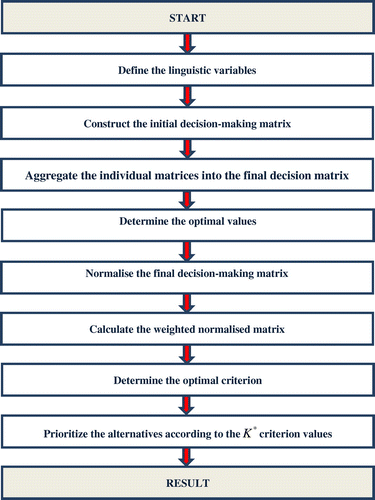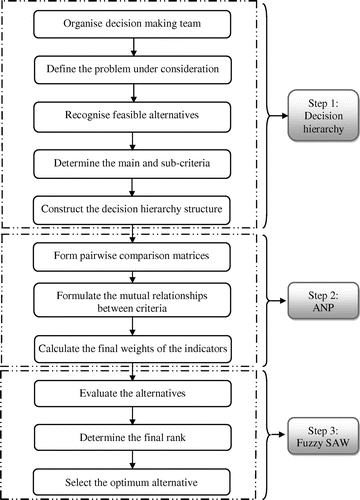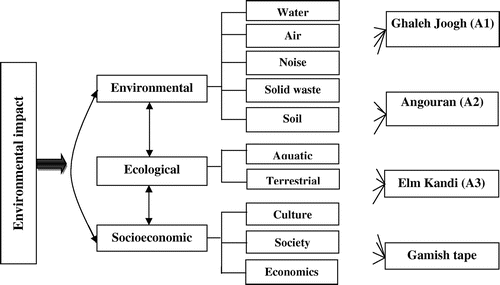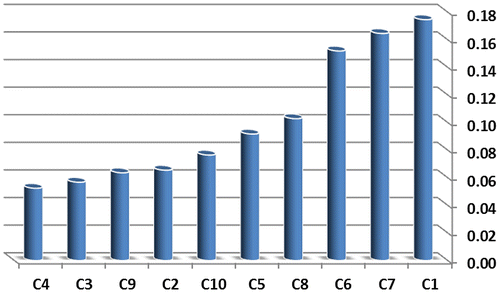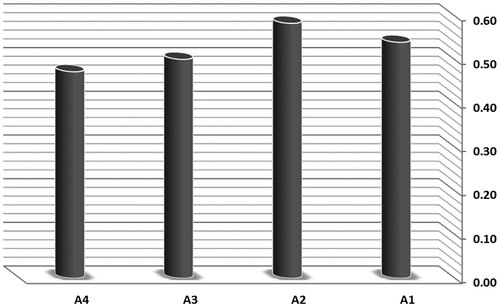Abstract
Mining operations usually comprise a spread spectrum of environmental challenges, which are often unique to each mine site. This is due to the fact that mining activities, directly or indirectly, have an adverse impact on environment and ecology. For this reason, the environmental impact assessment (EIA) process has been developed for evaluation of the possible impact of mine development and operations on the environment, including the natural, social and economic aspects. In this article, an EIA methodology based on analytic network process and fuzzy simple additive weight (SAW) is proposed to formulate the environmental risks pertaining to mining projects. In the system of the proposed model, the importance weights are calculated by an ANP process. Then, fuzzy SAW is employed to evaluate the preference ratings of the alternatives. The merit of using fuzzy logic is to handle the inherent uncertainty in modelling an EIA problem by simplifying the sophisticated structure of the problem under consideration. The proposed model is utilised to assess the environmental impact generated by zinc and lead mining projects located in Zanjan, Iran to shape the future industrial and mining structure of the region. Finally, the environmental impacts are ranked from the most to the least risky.
1. Introduction
Mining activities are distinguished as one of the greatest threats to the planet’s environment. These activities produce a huge amount of waste that can have harmful effects for decades. The environmental effects of the mining industry include destruction of natural habitats, changes in river regimes and water tables, and other serious ecological impacts (UNEP, Citation2000). Although the mining industry has been making improvements, some key problems are still to be resolved. This means that there is a fundamental need to reduce the severity and number of deleterious effect before, during, and after mining activities. Therefore, environmental management measures are accomplished by mining societies to mitigate the adverse impacts from mining operations in order to prevent, reduce or eliminate contamination or any degradation of the environment. This mitigation may be a result of implementation of a project alternative or project modifications or environmental protection measures, which simply reduce the number or magnitude of negative impacts (Anjaneyulu & Manickam, Citation2007). Consequently, environmental impact assessors and mining designers grapple with complex and costly invasive problems. Therefore, it is of vital importance to assess the environmental impacts for conducting stringent controls on pollution.
To achieve the aim, different models have been developed for formulating the impacts of any developmental endeavour to ensure the activity does not harm the environment. These include environmental impact assessments (EIAs), environmental management systems, environmental accounting, environmental audits and environmental reports, and life cycle assessment (Sinding, Citation1999).
These methods aim at identifying all the parameters that contribute to the preservation and protection of the natural environment or have other impacts such as human health, labour accidents (Daniel, Tsoulfas, Pappis, & Rachaniotis, Citation2004). EIA, one of the most popular tools for environmental risk assessment, has been broadly employed as proactive decision support tool to diminish or mitigate the potential impact connected with any developmental activity (Collins et al., Citation2013; Deng, Hu, Deng, & Mahadevan, Citation2014; Garraín & Lechó, Citation2014; Haichao, Wenling, Lahdelma, Pinghua, & Shuhui, Citation2013; Kim, Choi, Mha, & Joung, Citation2013; Liu, Sheu, & Tseng, Citation2013; Momtaz & Kabir, Citation2013; Phillips, Citation2013; Salbu et al., Citation2013; Salomons & Hoberg, Citation2014).
The EIA is an activity designed to identify and predict the impact of a project on environment and human health so as to recommend appropriate legislative measures, programmes, and operational procedures to minimise the impact (Anjaneyulu & Manickam, Citation2007). This technique uses a well-organised and systematic approach to help authorities avoid costly effects of developmental activities to the environment. The EIA has some salient features including: (1) the EIA helps to identify the positive and negative impacts to the environment in the short- and long-term; (2) the EIA decreases or offsets the undesirable impacts of an activity leading to a reduction in environmental degradation; and (3) The EIA provides a monitoring process to control and manage the level of project implementation and the degree of successfulness of the environmental protection measures.
However, the assessment of environmental impacts in order to make a decision cannot be a straightforward process because a large number of parameters may significantly affect the natural environment. Therefore, authorities are faced with a multi-criteria decision-making issue.
The simple additive weight (SAW) is one of the most popular techniques in modelling an a multi criteria decision making (MCDM) problem. This technique is employed by different researchers for the following reasons: (1) the logic used in the process of modelling is understandable and rational; (2) the computations are straightforward; and (3) this method is clearly described by a simple mathematical form. However, the SAW method is unable to deal with the imprecise and ambiguous detail involved in real-life decision-making problems, so that, without taking the inherent uncertainty into account, the results are unrealistic and may be a cause of unreliable assessment. Fuzzy logic is a powerful mathematical tool for dealing with the inherent uncertainty. This method demonstrates its worth as a practical problem-solving tool. On the other hand, analytical network process has several advantages (Fouladgar, Yazdani-Chamzini, Zavadskas, & Moini, Citation2012): (1) Analytic network process (ANP) can measure all tangible and intangible criteria in the model; (2) ANP is a relatively simple, intuitive approach that can be accepted by managers and other decision-makers; (3) ANP allows for more complex relationship among the decision levels and attributes as it does not require a strict hierarchical structurel; and (4) ANP is more adapted with real world problems. In this article, an integrated model based on ANP and fuzzy SAW is proposed to assess the environmental impacts of lead and zinc mining projects located in Zanjan, Iran. For achieving the aim, the ANP method is employed for computation of the relative importance of the evaluation criteria and fuzzy SAW is applied for evaluation of the performance ratings of the feasible alternatives by using linguistic terms.
2. Environmental impact assessment
EIA is defined as a systematic and organised process for identification and evaluation of the potential impacts of any activity pertaining to the physical, chemical, biological, cultural, and socioeconomic components of the total environment (Canter, Citation1996; Liu & Lai, Citation2009). The EIA has been a significant development in environmental management over the last two decades. This technique incorporates requirement for social, climatic, and cultural characteristics to enable decision makers to carry out a comprehensive analysis on the problem under consideration.
3. Risk management by using importance–performance analysis
Importance–performance analysis (IPA), introduced by Martilla and James (Citation1977), is a useful framework to manage firms’ strategies. The IPA is a systematic tool to rank elements by taking both the importance and performance perspectives into account simultaneously. This method can assist decision-makers in identifying the most important elements in order to make promotional efforts and further improvement. The IPA can be employed for analysing the weaknesses in order to enable the authorities to promote the environmental prevention measures.
This technique combines measures of attribute importance and performance into a two-dimensional grid as shown in Liu and Yu (Citation2009). The grid is divided into four quadrants, where the y-axis depicts the importance and x-axis depicts the performance. Therefore, each attribute is placed into one of the four quadrants, including quadrant I (high importance/high performance), quadrant II (high importance/low performance), quadrant III (low importance/low performance), and quadrant IV (low importance/high performance).
Attributes located in quadrant I (maintain performance) indicate that the current situation has a high potential for developing; whereas, attributes located in quadrant II (focus effort here) require immediate remedial action. Attributes located in quadrant III (low priority) do not need extra effort; whereas, attributes located in quadrant IV (reduce emphasis) indicate insignificant strengths for firms.
4. Fuzzy SAW
The SAW method is widely employed for modelling decision-making problems (Chou, Chang, & Shen, Citation2008; Hashemkhani Zolfani, Sedaghat, & Zavadskas, Citation2012; Hwang & Yoon, Citation1981; Medineckienė & Björk, Citation2011; Palevičius, Paliulis, Venckauskaite, & Vengrys, Citation2013; Sagar, Jayaswal, & Kushwah, Citation2013; Tamošaitiene, Šipalis, Banaitis, & Gaudutis, Citation2013). The basic concept of SAW is to acquire a weighted sum of the preference ratings of each alternative with respect to the criteria under consideration. The SAW technique comprises two main steps (Chou et al., Citation2008; Hwang & Yoon, Citation1981): (1) normalise the values of all attributes to make them comparable; and (2) sum up the values of the all attributes for each alternative.
The SAW method uses a systematic methodology to rank the feasible alternatives in descending order of preference. Although the SAW technique has been successfully employed for decision-making problems, this method is less effective when faced with the inherent uncertainty involved in the process of decision-making. The merit of using fuzzy logic is to calculate the importance or preference of criteria and alternatives using fuzzy numbers instead of crisp numbers to be more adapted to the real world cases (Yazdani-Chamzini & Yakhchali, Citation2012).
This technique employs linguistic variable instead of traditional quantitative expression, which is a very helpful concept for dealing with situations which are too complex or not well-defined enough (Zadeh, Citation1965). Therefore, fuzzy SAW has been developed to accurately model a decision-making problem.
This technique conducts a step-by-step approach to prioritise the feasible alternatives based on their preference with ambiguous or rough data. The process of fuzzy SAW can be mathematically defined as follows:
Step 1. Define the linguistic terms and fuzzy ratings.
Step 2. Form the decision-making matrix.
Step 3. Aggregate the decision matrices into the final decision matrix.
Step 4. Normalise the final matrix. The process of normalisation of the decision matrix can be described as follows:
(1)
(2)
Step 5. Calculate the weighted normalised matrix. Values of the matrix are calculated by multiplying values of the elements of the normalised matrix with the corresponding weights of significances of each criterion:
Step 6. Define the efficiency criterion for each ith alternative.
(3)
Step 7. Optimum variant and ranks of the alternatives are established by size
:
(4)
The schematic diagram of the fuzzy SAW is depicted step by step in Figure .
5. Analytic network process
The analytic hierarchy process (AHP) (Saaty, Citation1980), a mathematical-based model, is employed for multi-criteria decision-making problem in order to help authorities to accurately analyse the decision issue by decomposing a sophisticated problem into a hierarchy structure. The structure of hierarchy in the AHP comprises a multi-level form, including objectives, criteria, sub-criteria and alternatives. In the system of the AHP, a fundamental scale of relative magnitudes expressed in dominance units is applied to represent judgements in the form of paired comparisons (Daniel et al., Citation2004). This model is formed based on the assumptions of unidirectional, hierarchical relationship among decision levels (Erdoğmus, Kapanoglu, & Koc, Citation2005). Many decision problems cannot be structured hierarchically because they involve the interaction and dependence of higher-level elements in a hierarchy on lower-level elements, therefore creating a network of elements is needed (Begičević, Divjak, & Hunjak, Citation2010).
However, the AHP technique is not capable of handling the mutual relationships between criteria. ANP, one of the most comprehensive frameworks of MCDM methods, is applied to identify the effects of the evaluation criteria on each other, to determine their importance. The ANP technique is a general form of the AHP method (Saaty, Citation1996). The AHP is proposed to solve the decision-making problem while there is independence among its elements; whereas, the ANP is developed to solve the problem including dependence among the elements. The ANP method is capable to takes into account both interaction and feedback within clusters of elements (inner dependence) and between clusters (outer dependence) (Önut, Tuzkaya, & Torun, Citation2011). The relative weights in a network are obtained similar to the AHP using pairwise comparisons and judgements (Table ).
Table 1. Pair-wise comparison scale.
The process of the ANP technique can be defined as follows:
Step 1. Identify the criteria and sub-criteria influencing the model significantly.
Step 2. Structure the decision hierarchy (goal, criteria, sub-criteria, and alternatives).
Step 3. Determine the local weights of the criteria and sub- criteria by using the format of the AHP method based on the two-by-two comparisons (assume that there is no dependence among the factors). The evaluator team uses the scale given in Table to measure the relative weights of the criteria and sub-criteria.
Step 4. Calculate the mutual relationships among criteria by using the inner dependence matrix of each criterion with respect to the other criteria. In order to compute the final weights of the criteria, the local weights of the criteria obtained in previous step are multiplied with the inner dependence matrix.
Step 5. Compute the overall weights of the sub-criteria. The overall weights are calculated by multiplying the local weight of the sub-criteria with its corresponding criteria.
6. The proposed model
The proposed model for evaluating the environmental impacts is established based on the ANP and fuzzy SAW techniques in the framework of the IPA, in which the ANP method obtains the importance component and the fuzzy SAW technique reflects the performance component. The model comprises three main stages: (1) identify the evaluation indicators; (2) obtain the importance weights of the indicators by the ANP method based on the pairwise comparison process; and (3) evaluate the feasible alternatives by using fuzzy SAW. The proposed model schematically is shown in Figure .
In the first stage, the evaluator team is formed and the problem under consideration is clearly explained. Then, the feasible alternatives and evaluation indicators are identified for selection of the optimum alternatives. In the last step of this stage, the decision hierarchy structure is constructed, including the overall goal (located in the first level), the main factors (located in the second level), the indicators (situated in the third level), and the feasible alternatives (located in the last level). Then, the relative importance of the main criteria and indicators are calculated by using the ANP technique in the format of pairwise comparison. In the last stage, the preference ratings of the alternatives with respect to the evaluation indicators are evaluated by using linguistic terms. Eventually, fuzzy SAW is utilised for evaluation of the alternatives and selection of the optimal alternative.
7. Environmental impact assessment in zinc and lead mining projects
Mining industry plays a significant role in Iran’s economy; so that, this industry includes 5% of the country’s GDPFootnote1. The country is known as one of the most important mineral producers in the world, ranked among 15 major mineral rich countries. This industry comprises more than 7% of the world’s total mineral reserves. The country holds some 68 types of minerals, 37 billion tonnes of proven reserves and more than 57 billion tonnes of potential reserves (Fouladgar, Yazdani-Chamzini, & Zavadskas, Citation2011). Zinc and lead are two most important minerals in Iran, the first is located in the highest rank and the latter is ranked the eleventh in the world. The country has over 220 million tonnes of proven zinc and lead ore reserves, including 11 million tonnes of zinc metal constituent and 5 million tonnes of lead metal constituent1. As a result, Iran solely has approximately 5% of the world’s metal constituent reserves.
Zanjan province, located in the northwest of Iran, is one of the most famous areas in lead and zinc production. This province has a number of mines including Ghaleh Joogh, Angouran, Elm Kandi, and Gamish tape. These mines are evaluated based on environmental impacts by using the proposed model in the following part.
7.1. Determine the importance of the indicators
Firstly, the factors influencing environment are extracted from literature review and a number of face-to-face interviews with expert team. The factors involved in the EIA model can be divided into three major classes: (1) environmental pollution (EN); (2) ecological alteration (EC); and (3) socioeconomic disturbance (SO). The first class comprises five indicators: water (C1), air (C2), noise (C3), solid waste, (C4), and soil (C5). The second contains two indicators: aquatic (C6) and terrestrial (C7). The latter encompasses three indicators: culture (C8), society (C9), and economics (C10).
The structure of the decision hierarchy for the problem under consideration is depicted in Figure . The decision problem consists of four levels: the overall goal of the problem is situated at the top level, the second level belongs to the main criteria, the sub-criteria are located in the third level, and the last level belongs to the alternatives.
Then, the local weights of the main and sub-criteria are calculated with the aid of the format of the ANP questionnaire by expert team (including eight evaluators with a high background in the field of risk management) based on the pairwise comparison matrices. It is noted that the weights of the evaluators are considered as the same value. After that, the comparison matrices are aggregated into the final comparison matrix by applying the geometric mean method as presented in Tables . In order to valid the matrices, the group consistency index (GCI) is calculated and then the group consistency ratio (GCR) is computed. The GCI can be mathematically defined as:
Table 2. Local weights of the main factors.
Table 3. Local weights of the environmental pollution sub-factors.
Table 4. Local weights of the ecological alteration sub-factors.
Table 5. Local weights of the socioeconomic disturbance sub-factors.
How to determine the weights of the evaluators? Are their weights equal? It should be noted clearly.(5)
where is the largest eigenvalue; and n is the number of the criteria under consideration. The GCR is obtained as
(6)
The Random Consistency Index (RCI) is derived from a randomly generated square matrix. The group judgement is consistent provided that the GCR is less than 0.1.
After computing the local weights, the interdependence relationships among the environmental, ecological, and socioeconomic factors are calculated as presented in Tables .
Table 6. The inner dependence matrix of the factors with respect to the ‘environmental pollution factor’.
Table 7. The inner dependence matrix of the factors with respect to ‘ecological alteration factor’.
Table 8. The inner dependence matrix of the factors with respect to ‘socioeconomic disturbance factor’.
Next, the local weights of the main factors are multiplied with the interdependence weights to obtain the global weights of the main factors.
As shown above, the results are significantly different from when the interdependent weights are neglected. The final results change from 0.36 to 0.40, 0.21 to 0.29, and 0.43 to 0.31 for the priority values of factors EN, EC, and SO, respectively.
Finally, the importance weights of the evaluation indicators are calculated by multiplying the local weights of the sub-criteria with the global weights of the factor to which it belongs. After normalising the weights, the global weights of the evaluation indicators are presented in Figure and Table .
Table 9. Overall weight of the evaluation indicators.
7.2. Determine of the performance ratings of the alternatives
After calculating the relative weights of the indicators, a linguistic scale for describing the preference ratings of the alternatives is defined as presented in Table . The evaluator team uses the scale given in the table to form the individual decision matrix. In order to reflect all experts’ opinions, the primary decision matrix is aggregated into the final decision matrix by using the arithmetic mean method as shown in Table .
Table 10. Linguistic terms for the performance rating of alternatives.
Table 11. The aggregated fuzzy evaluation matrix.
7.3. IPA for managing risk in EIA review
Based on the basic concepts of the IPA technique, the importance-performance matrix is established by combining the values of both importance weights and performance ratings into the final decision matrix. Next, the fuzzy SAW methodology is applied for combining the importance weights of the indicators and performance ratings of the alternatives (Table ). The alternatives are ranked in descending order as listed in Table .
Table 12. The weighted normalised decision matrix.
According to K values, the ranking of the alternatives in descending order are A2, A1, A3, and A4. The proposed model results indicate that Anguran mine project (A2) is the riskiest project with K value of 0.584. Rankings of risks according to K values are depicted in Figure .
8. Conclusion
EIA provides a systematic and organised tool for better decision-making. This method can simultaneously take environmental, ecological, and socioeconomic perspectives into account. The EIA technique uses the process of identifying, evaluating, and assessing the environmental impacts of developmental activities. However, this problem is a sophisticated and complex problem because of lack of information and different parameters that may comprise tangible and intangible factors. The fuzzy set theory provides a mathematical way to face with vagueness which often better formulate the real world problems. In this article, an EIA approach based on an integrated model is proposed to formulate zinc and lead mining projects located in Zanjan, Iran. In the system of the proposed model, the ANP technique is employed for calculation of the criteria weights. Then, fuzzy SAW is utilised to evaluate the environmental impact produced through different zinc and lead mining projects and rank the alternatives from the one with the lowest impact to the highest. The proposed model is successfully employed for assessing the risk of zinc and lead mining projects in Zanjan. The model demonstrates its potential application as a practical problem-solving tool. It is proposed for future work to employ the proposed model for assessing the environmental impacts of different construction projects.
Notes
1. en.wikipedia.org.
References
- Anjaneyulu, Y., & Manickam, V. (2007). Environmental impact assessment methodologies (2nd ed.). Hyderabad: BS Publications.
- Begičević, N., Divjak, B., & Hunjak, T. (2010). Decision-making on prioritization of projects in higher education institutions using the analytic network process approach. Central European Journal of Operations Research, 18, 341–364.10.1007/s10100-009-0113-3
- Canter, L. (1996). Environmental impact assessment. Singapore: McGraw-Hill.
- Chou, S. Y., Chang, Y. H., & Shen, C. Y. (2008). A fuzzy simple additive weighting system under group decision-making for facility location selection with objective/subjective attributes. European Journal of Operational Research, 189, 132–145.10.1016/j.ejor.2007.05.006
- Collins, P. C., Croot, P., Carlsson, J., Colaço, A., Grehan, A., Hyeong, K., … Kennedy, R. (2013). A primer for the environmental impact assessment of mining at seafloor massive sulfide deposits. Marine Policy, 42, 198–209.10.1016/j.marpol.2013.01.020
- Daniel, S. E., Tsoulfas, G. T., Pappis, C. P., & Rachaniotis, N. P. (2004). Aggregating and evaluating the results of different environmental impact assessment methods. Ecological Indicators, 4, 125–138.10.1016/j.ecolind.2004.01.003
- Deng, X., Hu, Y., Deng, Y., & Mahadevan, S. (2014). Environmental impact assessment based on D numbers. Expert Systems with Applications, 41, 635–643.10.1016/j.eswa.2013.07.088
- Erdoğmus, S., Kapanoglu, M., & Koc, E. (2005). Evaluating high-tech alternatives by using analytic network process with BOCR and multiactors. Evaluation and Program Planning, 28, 391–399.10.1016/j.evalprogplan.2005.07.003
- Fouladgar, M. M., Yazdani-Chamzini, A., & Zavadskas, E. K. (2011). An integrated model for prioritizing strategies of the Iranian mining sector. Technological and Economic Development of Economy, 17, 459–483.10.3846/20294913.2011.603173
- Fouladgar, M. M., Yazdani-Chamzini, A., Zavadskas, E. K., & Moini, S. H. H. (2012). A new hybrid model for evaluating the working strategies: Case study of construction company. Technological and Economic Development of Economy, 18, 164–188.10.3846/20294913.2012.667270
- Garraín, D., & Lechó, Y. (2014). Exploratory environmental impact assessment of the manufacturing and disposal stages of a new PEM fuel cell. International Journal of Hydrogen Energy, 39, 1769–1774.
- Haichao, W., Wenling, J., Lahdelma, R., Pinghua, Z., & Shuhui, Z. (2013). Atmospheric environmental impact assessment of a combined district heating system. Building and Environment, 64, 200–212.10.1016/j.buildenv.2013.02.011
- Hashemkhani Zolfani, S., Sedaghat, M., & Zavadskas, E. K. (2012). Performance evaluating of rural ICT centers (telecenters), applying fuzzy AHP, SAW-G and TOPSIS Grey, a case study in Iran. Technological and Economic Development of Economy, 18, 364–387.10.3846/20294913.2012.685110
- Hwang, C. L., & Yoon, K. (1981). Multiple attributes decision making methods and applications. New York, NY: Springer Berlin Heidelberg.10.1007/978-3-642-48318-9
- Kim, S. H., Choi, M. S., Mha, H. S., & Joung, J. Y. (2013). Environmental impact assessment and eco-friendly decision-making in civil structures. Journal of Environmental Management, 126, 105–112.10.1016/j.jenvman.2013.03.045
- Liu, K. F. R., & Lai, J. H. (2009). Decision-support for environmental impact assessment: A hybrid approach using fuzzy logic and fuzzy analytic network process. Expert Systems with Applications, 36, 5119–5136.10.1016/j.eswa.2008.06.045
- Liu, K. F. R., & Yu, C. W. (2009). Integrating case-based and fuzzy reasoning to qualitatively predict risk in an environmental impact assessment review. Environmental Modelling & Software, 24, 1241–1251.
- Liu, T. K., Sheu, H. Y., & Tseng, C. N. (2013). Environmental impact assessment of seawater desalination plant under the framework of integrated coastal management. Desalination, 326, 10–18.10.1016/j.desal.2013.07.003
- Martilla, J. A., & James, J. C. (1977). Importance–performance analysis. Journal of Marketing, 41, 77–79.10.2307/1250495
- Medineckienė, M., & Björk, F. (2011). Owner preferences regarding renovation measures – The demonstration of using multi-criteria decision making. Journal of Civil Engineering and Management, 17, 284–295.10.3846/13923730.2011.582380
- Momtaz, S., & Kabir, S. M. Z. (2013). Evaluating environmental and social impact assessment: Framework for effective EIA system. In Evaluating Environmental and Social Impact Assessment in Developing Countries (pp. 171–187). Amsterdam: Elsevier.10.1016/B978-0-12-408129-1.00008-5
- Önut, S., Tuzkaya, U. R., & Torun, E. (2011). Selecting container port via a fuzzy ANP-based approach: A case study in the Marmara Region. Turkey, Transport Policy, 18, 182–193.
- Palevičius, V., Paliulis, G. M., Venckauskaite, J., & Vengrys, B. (2013). Evaluation of the requirement for passenger car parking spaces using multi-criteria methods. Journal of Civil Engineering and Management, 19, 49–58.10.3846/13923730.2012.727463
- Phillips, J. (2013). The application of a mathematical model of sustainability to the results of a semi-quantitative environmental impact assessment of two iron ore opencast mines in Iran. Applied Mathematical Modelling, 37, 7839–7854.10.1016/j.apm.2013.03.029
- Saaty, T. L. (1980). The analytic hierarchy process. New York, NY: McGraw-Hill.
- Saaty, T. L. (1996). Decision making with dependence and feedback: The analytic network process. Pittsburgh, PA: RWS Publications.
- Sagar, M. K., Jayaswal, P., & Kushwah, K. (2013). Exploring fuzzy SAW method for maintenance strategy selection problem of material handling equipment. International Journal of Current Engineering and Technology, 3, 600–605.
- Salbu, B., Burkitbaev, M., Strømman, G., Shishkov, I., Kayukov, P., Uralbekov, B., & Rosseland, B. O. (2013). Environmental impact assessment of radionuclides and trace elements at the Kurday U mining site, Kazakhstan. Journal of Environmental Radioactivity, 123, 14–27.10.1016/j.jenvrad.2012.05.001
- Salomons, G. H., Hoberg, G. (2014). Setting boundaries of participation in environmental impact assessment. Environmental Impact Assessment Review, 45, 69–75.
- Sinding, K. (1999). Environmental impact assessment and management in the mining industry. Natural Resources Forum, 23, 57–63.10.1111/narf.1999.23.issue-1
- Tamošaitienė, J., Šipalis, J., Banaitis, A., & Gaudutis, E. (2013). Complex model for the assessment of the location of high-rise buildings in the city urban structure. International Journal of Strategic Property Management, 17, 93–109.
- UNEP. (2000). Industry and environment – Mining and sustainable development II; Challenges and perspectives. Vol. 23. Retrieved from http://www.uneptie.org/media/review/vol23si/unep23.pdf
- Yazdani-Chamzini, A., & Yakhchali, S. H. (2012). Tunnel Boring Machine (TBM) selection using fuzzy multicriteria decision making methods. Tunnelling and Underground Space Technology, 30, 194–204.10.1016/j.tust.2012.02.021
- Zadeh, L. A. (1965). Fuzzy sets. Information and Control, 8, 338–353.10.1016/S0019-9958(65)90241-X

